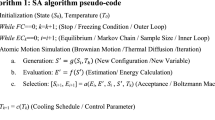Abstract
Due to shortcomings of genetic algorithm that its convergence speed is slow and it is often premature convergence, a new improved genetic algorithm—fuzzy adaptive simulated annealing genetic algorithm (FASAGA) is presented by integrating fuzzy inference, simulated annealing algorithm and adaptive mechanism. The strong Markovian property attributed to the population sequence was deduced by mathematical modeling. Then the convergence in probability of the FASAGA was proved on the condition that the time tended to infinity. Then convergence speed of FASAGA was estimated and some quantitative results were achieved. The simulation results validated the theoretical analysis conclusions. This work is helpful to further analyze and improve optimization performance of FASAGA and other hybrid genetic algorithms.
Similar content being viewed by others
References
M. Srinivas, “Adaptive probabilities of crossover and mutation in genetic algorithms,” IEEE Trans. on Systems, Man and Cybernetics, vol. 24, no. 4, pp. 656–667, April 1994.
L. L. Zhu, H. C. Zhang, and Y. Z. Jtng, “Application of fuzzy adaptive genetic algorithm in multi-sensor multitarget tracking,” Information and Control, vol. 32, no. 7, pp. 711–715, July 2003.
F. Herrera, M. Lozano, and J. L. Verdegay, “Fuzzy connectives based crossover operators to model genetic algorithms population diversity,” Fuzzy Sets and Systems, vol. 92, no. 1, pp. 21–30, November 1997.
Y. Yun and M. Gen, “Performance analysis of adaptive genetic algorithms with fuzzy logic and heuristics,” Fuzzy Optimization and Decision Making, vol. 2, no. 2, pp. 161–175, February 2003.
M. Kaya, “The effects of two new crossover operators on genetic algorithm performance,” Applied Soft Computing, vol. 11, no. 1, pp. 881–890, January 2011.
O. B. Augusto, S. Rabeau, Ph. Depince, and F. Bennis, “Multi-objective genetic algorithms: A way to improve the convergence rate,” Engineering Applications of Artificial Intelligence, vol. 19, no. 5, pp. 501–510, August 2006.
K. C. Sarma and H. Adeli, “Fuzzy genetic algorithm for optimization of steel structures,” Journal of Structural Engineering, vol. 126, no. 5, pp. 596–614, May 2000.
G. C. Liao, “Application of a fuzzy neural network combined with a chaos genetic algorithm and simulated annealing to short-term load forecasting,” IEEE Trans. on Evolutionary Computation, vol. 10, no. 3, pp. 330–340, June 2006.
C. F. Juang, “A hybrid of genetic algorithm and particle swarm optimization for recurrent network design,” IEEE Trans. on Systems, Man and Cybernetics—Part B: Cybernetics, vol. 34, no. 2, pp. 997–1006, April 2004.
L. C. Jiao and L. Wang, “A novel genetic algorithm based on immunity,” IEEE Trans. on Systems, Man and Cybernetics—Part A: Systems and Humans, vol. 30, no. 5, pp. 552–561, September 2000.
X. P. Luo and W. Wei, “A new immune genetic algorithm and its application in redundant manipulator path planning,” Journal of Robotic Systems, vol. 21, no. 3, pp. 141–151, March 2004.
Y. C. Chiu, L. C. Chang, and F. J. Chang, “Using a hybrid genetic algorithm-simulated annealing algorithm for fuzzy programming of reservoir operation,” Hydrol. Process, vol. 21, no. 3, pp. 3162–3172, November 2007.
J. M. Xie, X. F. Xu, B. Chen, Y. P. Chen, and W. Ai, “Optimized scheduling of electrical vehicle network based on genetic simulated,” China Mechanical Engineering, vol. 8, no. 14, pp. 1697–1700, July 2007.
X. Wang, A. G. Jiang, and S. Wang, “Optimal designs of wireless sensor network by adapted GASA,” Control Theory & Applications, vol. 23, no. 4, pp. 593–596, April 2006.
K. P. Wong and S. Y. W. Wong, “Combined genetic algorithm/simulated annealing/fuzzy set approach to short-term generation scheduling with take-or-pay fuel contract,” IEEE Trans. on Power System, vol. 11, no. 1, pp. 128–136, February 1996.
W. X. Zhang and Y. Leung, Mathematical Foundation of Genetic Algorithms, The Xi’an Jiaotong University Pres, Xi’an, China. 2000.
D. Reynolds and J. Gomatam, “Theoretical bounds for genetic algorithms,” Proc. of International Conference on Artificial Neural Networks and Genetic Algorithms, Ales, France. pp. 148–151, 1995.
H. Peng and X. H. Wang, “The convergence rate estimation of genetic algorithm with elitist,” Chinese Science Bulletin, vol. 42, no. 2, pp. 144–147, February 1997.
L. He, K. J. Wang, G. B. Li, and H. Z. Jin, “The convergence rate estimation of genetic algorithm,” Systems Engineering-Theory Methodology Application, vol. 8, no. 3, pp. 22–26, March 1999.
W. Z. Yang, D. L. Li, and L. Zhu, “An improved genetic algorithm for optimal feature subset selection from multi-character feature set,” Expert Systems with Applications, vol. 38, no. 3, pp. 2733–2740, March 2011.
G. Rudoph, “Convergence analysis of canonical genetic algorithms,” IEEE Trans. on Neural Networks, vol. 5, no. 1, pp. 96–101, January 1994.
Author information
Authors and Affiliations
Corresponding author
Additional information
Recommended by Associate Editor Sungshin Kim under the direction of Editor Zengqi Sun.
This work is supported by the NSFC (61203299), the Natural Science Foundation of Zhejiang province, China (Y1110135, LY12F03018), the Fundamental Research Funds for the Central Universities (2013QNA4021), the Zhejiang Province “Qiangjiang” Talents Program of China (2013R10047) and National 863 Projects of China (2014AA052001).
Yonggang Peng received his Ph.D. degree in Control Theory and Control Engineering from Zhejiang University in 2008 and now he is an associate professor in Zhejiang University. His research interests include intelligent control, evolutionary optimization, and smart grid.
Xiaoping Luo received his Ph.D. degree in Control Theory and Control Engineering from Zhejiang University in 2008. His research interests include evolutionary optimization, and intelligent control.
Wei Wei received his Ph.D. degree in Control Theory and Control Engineering from Zhejiang University in 1994 and now he is a professor in Zhejiang University. His research interests include intelligent control, robot, and smart grid.
Rights and permissions
About this article
Cite this article
Peng, Y., Luo, X. & Wei, W. A new fuzzy adaptive simulated annealing genetic algorithm and its convergence analysis and convergence rate estimation. Int. J. Control Autom. Syst. 12, 670–679 (2014). https://doi.org/10.1007/s12555-011-0022-9
Received:
Revised:
Accepted:
Published:
Issue Date:
DOI: https://doi.org/10.1007/s12555-011-0022-9




